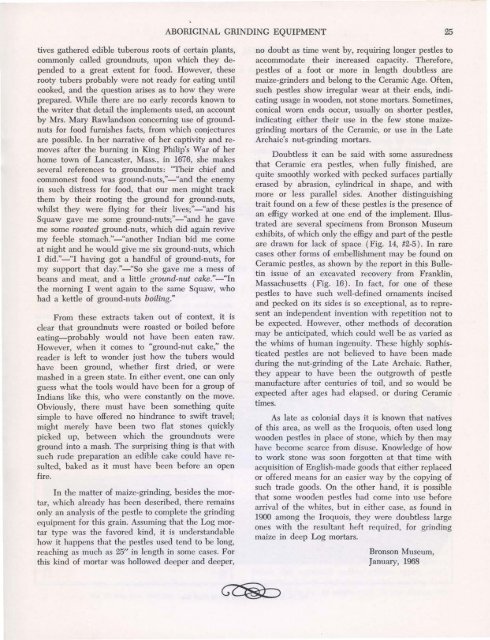Aboriginal Grinding Equipment, 31(1-2)
Aboriginal Grinding Equipment, 31(1-2)
Aboriginal Grinding Equipment, 31(1-2)
Create successful ePaper yourself
Turn your PDF publications into a flip-book with our unique Google optimized e-Paper software.
tives gathered edible tuberous roots of certain plants,<br />
commonly called groundnuts, upon which they depended<br />
to a great extent for food. However, these<br />
rooty tubers probably were not ready for eating until<br />
cooked, and the question arises as to how they were<br />
prepared. While there are no early records known to<br />
the writer that detail the implements used, an account<br />
by Mrs. Mary Rawlandson concerning use of groundnuts<br />
for food furnishes facts, from which conjectures<br />
are possible. In her narrative of her captivity and removes<br />
after the burning in King Philip's War of her<br />
home town of Lancaster, Mass., in 1676, she makes<br />
several references to groundnuts: "Their chief and<br />
commonest food was ground-nuts,"-"and the enemy<br />
in such distress for food, that our men might track<br />
them by their rooting the ground for ground-nuts,<br />
whilst they were flying for their lives;"-"and his<br />
Squaw gave me some ground-nuts;"-"and he gave<br />
me some roasted ground-nuts, which did again revive<br />
my feeble stomach."-"another Indian bid me come<br />
at night and he would give me six ground-nuts, which<br />
I did."-"I having got a handful of ground-nuts, for<br />
my support that day."-"So she gave me a mess of<br />
beans and meat, and a little ground-nut cake."-"In<br />
the morning I went again to the same Squaw, who<br />
had a kettle of ground-nuts boiling."<br />
From these extracts taken out of context, it is<br />
clear that groundnuts were roasted or boiled before<br />
eating-probably would not have been eaten raw.<br />
However, when it comes to "ground-nut cake," the<br />
reader is left to wonder just how the tubers would<br />
have been ground, whether first dried, or were<br />
mashed in a green state. In either event, one can only<br />
guess what the tools would have been for a group of<br />
Indians like this, who were constantly on the move.<br />
Obviously, there must have been something quite<br />
simple to have offered no hindrance to swift travel;<br />
might merely have been two flat stones quickly<br />
picked up, between which the groundnuts were<br />
ground into a mash. The surprising thing is that with<br />
such rude preparation an edible cake could have resulted,<br />
baked as it must have been before an open<br />
fire.<br />
In the matter of maize-grinding, besides the mortar,<br />
which already has been described, there remains<br />
only an analysis of the pestle to complete the grinding<br />
equipment for this grain. Assuming that the Log mortar<br />
type was the favored kind, it is understandable<br />
how it happens that the pestles used tend to be long,<br />
reaching as much as 25" in length in some cases. For<br />
this kind of mortar was hollowed deeper and deeper,<br />
ABORIGINAL GRINDING EQUIPMENT 25<br />
no doubt as time went by, requiring longer pestles to<br />
accommodate their increased capacity. Therefore,<br />
pestles of a foot or more in length doubtless are<br />
maize-grinders and belong to the Ceramic Age. Often,<br />
such pestles show irregular wear at their ends, indicating<br />
usage in wooden, not stone mortars. Sometimes,<br />
conical worn ends occur, usually on shorter pestles,<br />
indicating either their use in the few stone maizegrinding<br />
mortars of the Ceramic, or use in the Late<br />
Archaic's nut-grinding mortars.<br />
Doubtless it can be said with some assuredness<br />
that Ceramic era pestles, when fully finished, are<br />
quite smoothly worked with pecked surfaces partially<br />
erased by abrasion, cylindrical in shape, and with<br />
more or less parallel sides. Another distinguishing<br />
trait found on a few of these pestles is the presence of<br />
an effigy worked at one end of the implement. Illustrated<br />
are several specimens from Bronson Museum<br />
exhibits, of which only the effigy and part of the pestle<br />
are drawn for lack of space (Fig. 14, #2-5). In rare<br />
cases other forms of embellishment may be found on<br />
Ceramic pestles, as shown by the report in this Bulletin<br />
issue of an excavated recovery from Franklin,<br />
Massachusetts (Fig. 16). In fact, for one of these<br />
pestles to have such well-defined ornaments incised<br />
and pecked on its sides is so exceptional, as to represent<br />
an independent invention with repetition not to<br />
be expected. However, other methods of decoration<br />
may be anticipated, which could well be as varied as<br />
the whims of human ingenuity. These highly sophisticated<br />
pestles are not believed to have been made<br />
during the nut-grinding of the Late Archaic. Rather,<br />
they appear to have been the outgrowth of pestle<br />
manufacture after centuries of toil, and so would be<br />
expected after ages had elapsed, or during Ceramic<br />
times.<br />
As late as colonial days it is known that natives<br />
of this area, as well as the Iroquois, often used long<br />
wooden pestles in place of stone, which by then may<br />
have become scarce from disuse. Knowledge of how<br />
to work stone was soon forgotten at that time with<br />
acquisition of English-made goods that either replaced<br />
or offered means for an easier way by the copying of<br />
such trade goods. On the other hand, it is possible<br />
that some wooden pestles had come into use before<br />
arrival of the whites, but in either case, as found in<br />
1900 among the Iroquois, they were doubtless large<br />
ones with the resultant heft required, for grinding<br />
maize in deep Log mortars.<br />
Bronson Museum,<br />
January, 1968

















